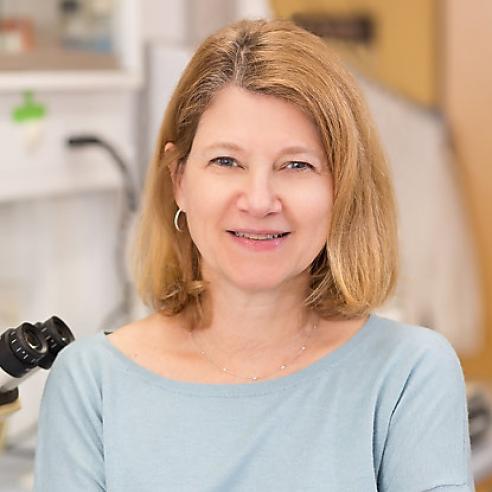Discovery Opens Path for Drugs to Treat, Prevent Devastating Eye Diseases
SALT LAKE CITY –Two major eye diseases and leading causes of blindness—age-related macular degeneration and diabetic retinopathy—can be reversed or even prevented by drugs that activate a protein found in blood vessel cells, researchers at the University of Utah School of Medicine and several other institutions have announced in a new study.
| Listen to a podcast that explains this research. Note: podcast not created by RPB. | |
Damage from both diseases was prevented and even reversed when the protein, Robo4, was activated in mice models that simulate age-related macular degeneration (AMD) and diabetic retinopathy, according to Dean Y. Li, M.D., Ph.D., senior author of the study published March 16 in Nature Medicine online.
Robo4 treated and prevented the diseases by inhibiting abnormal blood vessel growth and by stabilizing blood vessels to prevent leakage. Abnormal blood vessel growth and leakage are two primary factors in both age-related macular degeneration (AMD) and diabetic retinopathy. But the study's ramifications go beyond eye diseases.
Serious infections such as SARS (Severe Acute Respiratory Syndrome), for example, kill people when an infection destabilizes blood vessels, allowing fluids to leak into the lungs. Tumors hijack blood vessel growth to feed on nutrients and grow. Although this study did not prove Robo4 would treat those diseases, Li believes it merits investigation.
"Many diseases are caused by injury or inflammation destabilizing blood vessels and causing them to leak fluid into adjacent tissues as well," said Li, professor of internal medicine and an investigator with the University's Program in Human Molecular Biology and Genetics. "We found a natural pathway – the Robo4 pathway – that counterattacks this by stabilizing blood vessels."
"This discovery has significant implications for developing drugs that activate Robo4 to treat AMD and diabetic retinopathy," said Kang Zhang, M.D., Ph.D., associate professor of ophthalmology and visual sciences at the University of Utah's John A. Moran Eye Center and an investigator with the University's Program in Human Molecular Biology and Genetics. Li and Zhang's laboratories closely collaborated on the research, using the same animal models of AMD and diabetic retinopathy that are required for drug development. The collaboration means the time required to test the approach in people could be shortened, perhaps by years. Nonetheless, both Zhang and Li caution that getting new drugs to market still would take a number of years.
Randall J. Olson, M.D., director of the University's John A. Moran Eye Center and professor and chair of ophthalmology and visual sciences, called Li's finding historic.
"This is a major breakthrough in an area where the advances have been minimal," Olson said. "We are excited about taking this opening and moving the frontier forward with real hope for patients who have but few, often disappointing, options."
The discovery is a prime example of basic science research yielding a discovery with direct clinical applications, according to Hemin Chin, Ph.D., director of ocular genetics program at the National Eye Institute. "Given that vascular eye diseases, such as age related macular degeneration and diabetic retinopathy, are the number one cause of vision loss in the United States, the identification of new signaling pathways that prevent abnormal vessel growth and leakage in the eye represents a major scientific advancement," said Chin.
Blood vessel growth (angiogenesis) is critical in human development and as a response to injury or disease. In earlier research, Li had shown that a family of proteins, netrins, induce blood vessel and nerve growth in mice, a discovery with important ramifications for potential therapies to help people with too few blood vessels. But when the body grows new blood vessels at the wrong time or place, these blood vessels are often unstable and weak, which causes them to leak and potentially lead to diseases such as macular degeneration and diabetic retinopathy.
In 2003, Li's laboratory cloned Robo4 and showed it served the opposite function of netrins by inhibiting blood vessel growth and the destabilization that causes leakage. Robo4 is found only in cells in the interior surface of blood vessels and is activated by a protein called Slit. After being activated, Robo4 initiates a chain of biochemical events to stabilize blood vessels and prevent uncontrolled growth.
"Everything in biology has a yin (negative) and a yang (positive), and in the previous paper on netrins we brought attention to a new signaling pathway that induces vessels and nerves to grow," Li said. "Robo4 is the yin to that process, preventing new vessel growth by stabilizing the integrity of mature blood vessels."
Age-related macular degeneration is the most common cause of legal blindness in people age 65 or older and is expected to become an increasingly common and costly health issue as the number of older people in United States increases. Diabetic retinopathy is the most common cause of legal blindness in working-age Americans. Currently, there are an estimated 21 million people with diabetes.
Contact: Chris Nelson
christopher.nelson@hsc.utah.edu
801-581-7387
University of Utah Health Sciences
March 20, 2008
Related News: Macular Degeneration

Research to Prevent Blindness and Association of University Professors of Ophthalmology Announce 2025 Recipient of RPB David F. Weeks Award for Outstanding Vision Research
Maria Bartolomeo Grant, MD, is recognized for ground-breaking contributions to the field of vision research.

Research to Prevent Blindness and Association of University Professors of Ophthalmology Announce 2024 Recipient of RPB David F. Weeks Award for Outstanding Vision Research
Patricia Ann D’Amore, PhD, MBA, is recognized for ground-breaking contributions to the field of vision research.

Research to Prevent Blindness Marks $400 Million in Funding to Advance Eye Disease Research
RPB funds a new round of researchers and hits a milestone in supporting vision-related breakthroughs.

RPB Funding Helps Researchers Revive Light-Sensing Cells in Organ Donor Eyes
This ground-breaking research accomplishment will open new doors for research on neurodegenerative diseases like AMD.

Recording available: RPB webinar on Dry AMD and Geographic Atrophy
RPB grantees provide expert insight on geographic atrophy and dry AMD as part of the "Lunch & Learn" series.

Join Us for AMD Awareness Month
Join RPB and Apellis Pharmaceuticals for a virtual event on Feb. 25 to learn about cutting-edge research into geographic atrophy and dry AMD.
Subscribe
Get our email updates filled with the latest news from our researchers about preventing vision loss, treating eye disease and even restoring sight. Unsubscribe at any time. Under our privacy policy, we'll never share your contact information with a third party.
| General Info | Grants | News & Resources |



